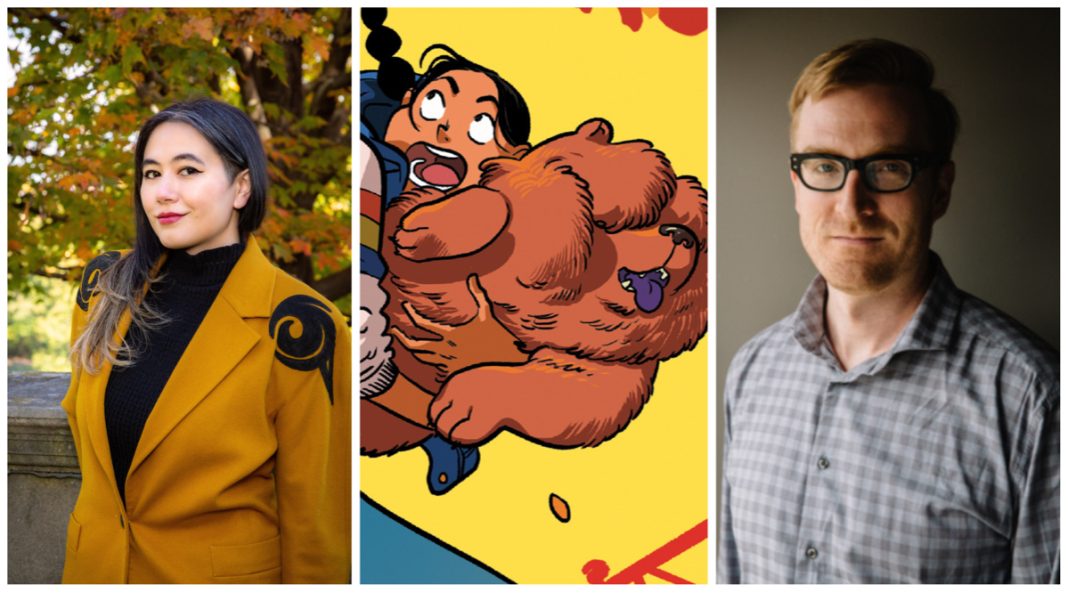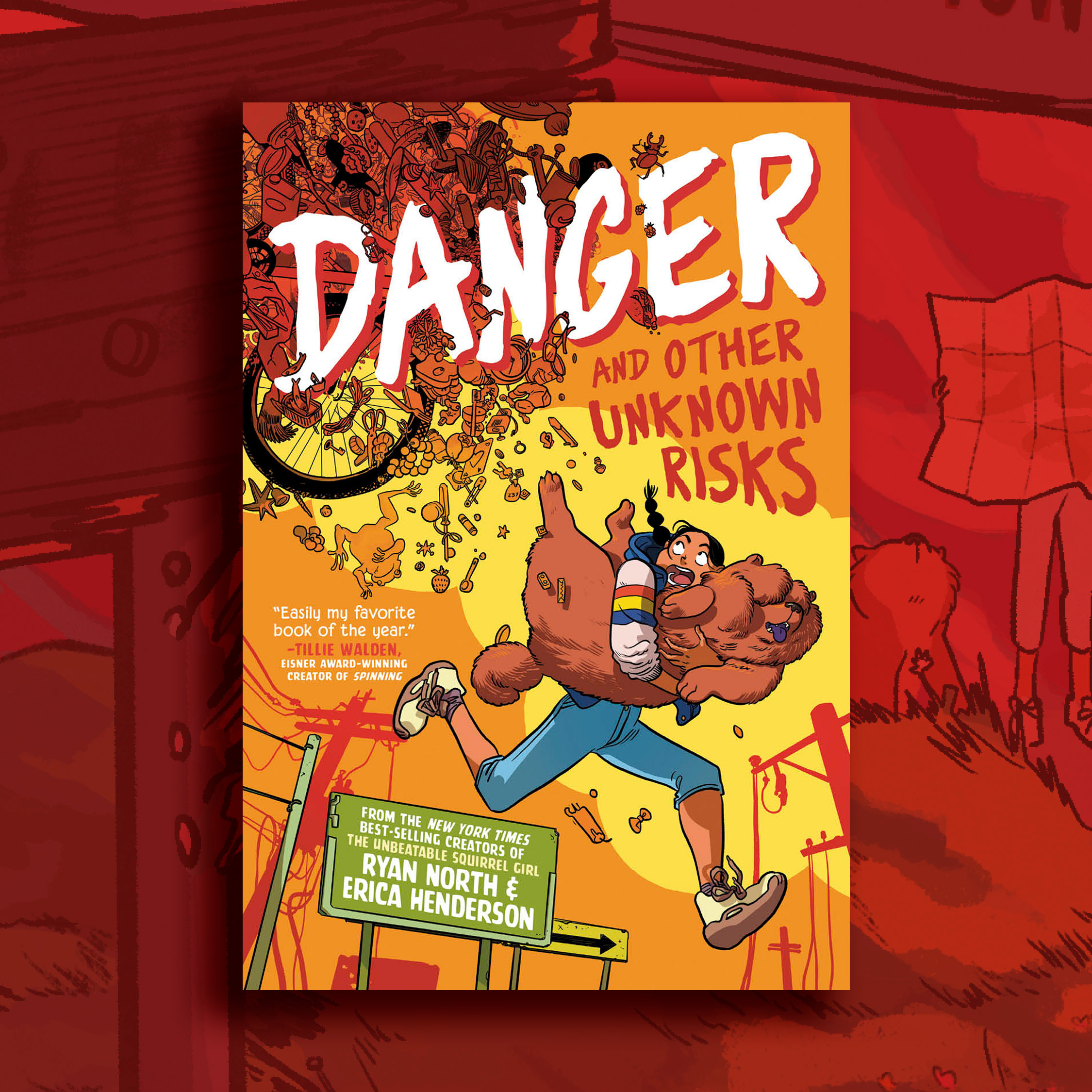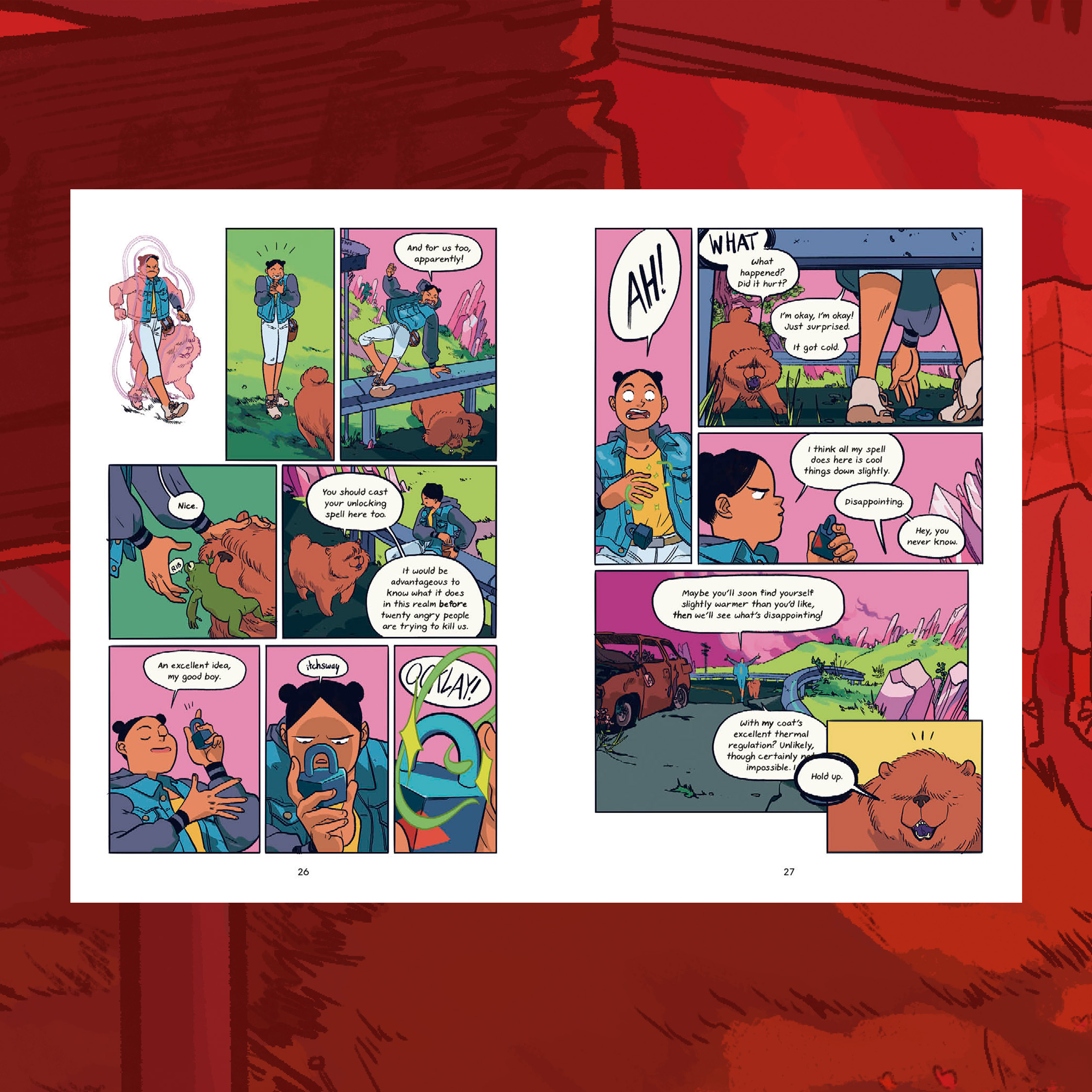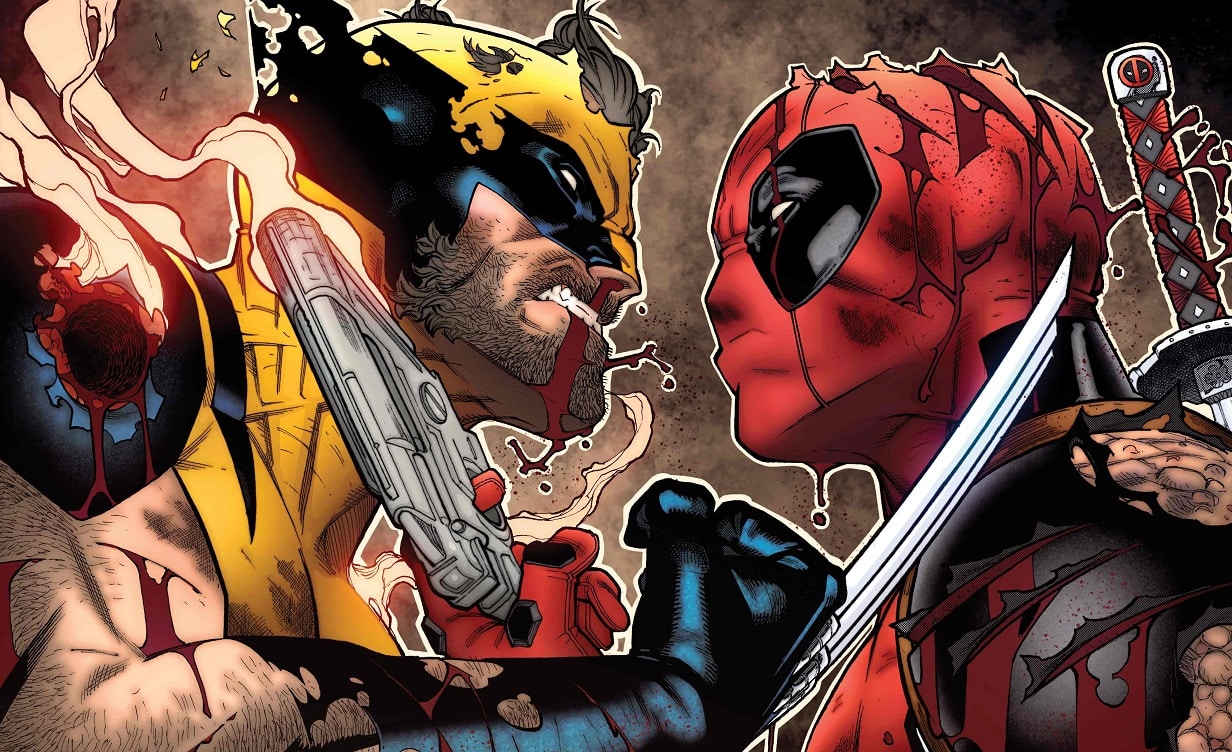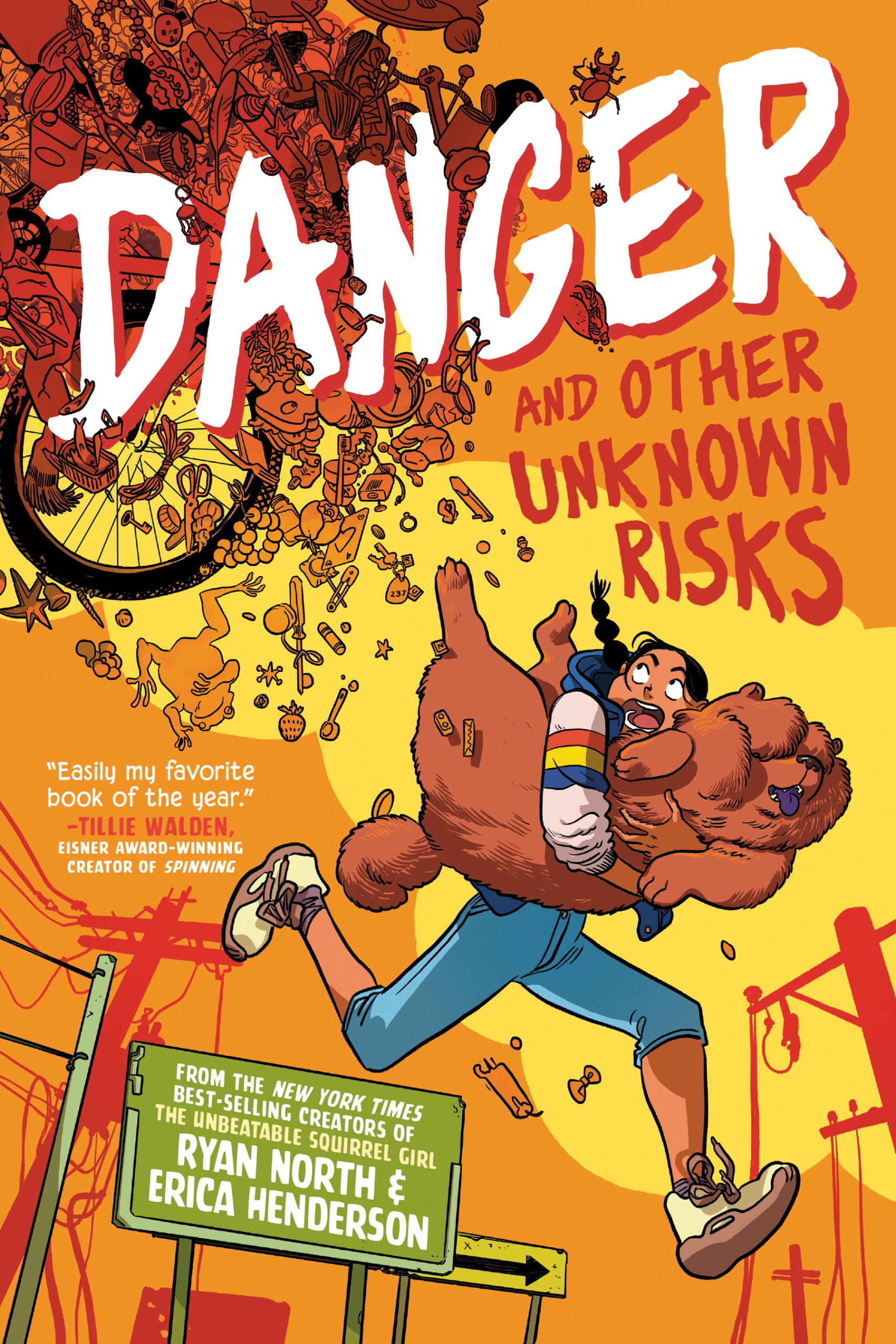
Danger and Other Unknown Risks, the upcoming graphic novel by Erica Henderson and Ryan North, is scheduled for publication on April 4th, 2023. The singular dystopian fantasy story will be published by Penguin Workshop and follows Marguerite de Pruitt and her faithful dog, Daisy, as they undertake a quest to avert cataclysmic chaos.
The Beat got the chance to catch up with Henderson and North over email and ask all about the collaborative creative process they utilized, find out why Y2K plays a key role in the graphic novel, and learn what goes into the characterization of a canine character!
AVERY KAPLAN: What was the origin story of this graphic novel?
ERICA HENDERSON: This is a really difficult one to answer because it came about fairly organically. First, I had a contract with Penguin but my collaborator fell through, so I asked Ryan if he wanted to do something. That was the extent of it when we started- “something.” We spent HOURS on the phone talking about ideas and things that interested us.
At one point it was a detective story. Ryan said he wanted to do a talking dog and I had no qualms with that, but it did kill the detective idea. Oddly, I think having a talking dog as our starting point was what got us to where we are. First, it gave us fantasy as a setting. Then, it gave us a companion, that’s where Marguerite comes in. Then when we had the classic “boy and his dog” team-up that lead us down the adventure route and all of the things we talked about and cared about could start finding its way into that adventure.
RYAN NORTH: Erica covers it well! This was a really fun proposition where we basically had carte blanche to tell a story – that’s a ton of trust from the publisher. We’d initially pitched this very different story – or even a collection of stories – and as I recall we didn’t really check in until months later when we’d developed this very different narrative from what we’d pitched!
Luckily (for us) everyone at the publisher was down with it, and maybe EXPECTED us to do something like that all along? But yes, it’s very fun to just hang out with a friend and talk about the different sorts of stories you could make.
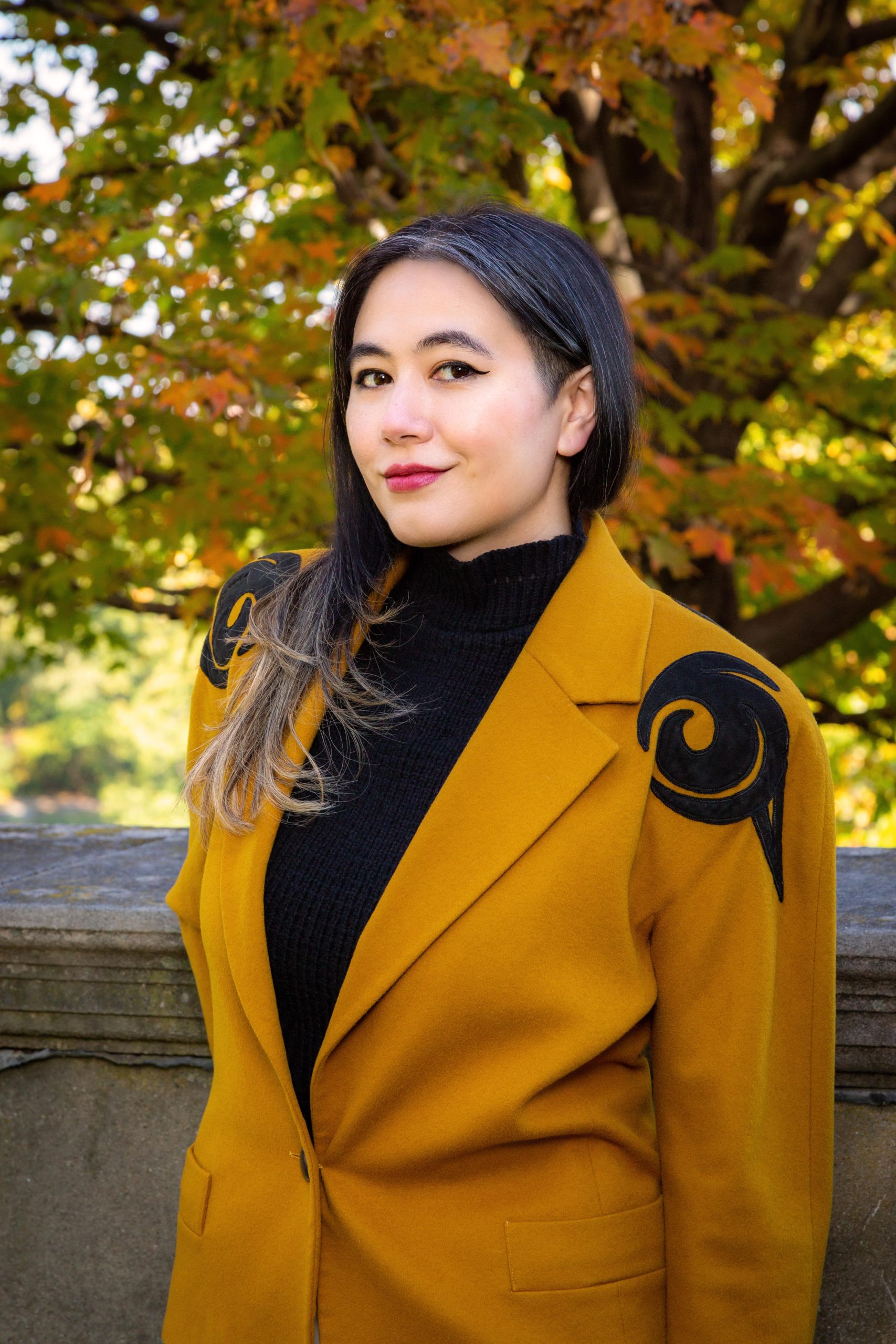
KAPLAN: Can you tell us a bit about how the collaborative creative process worked for Danger and Other Unknown Risks? And more specifically, what went into creating Marguerite de Pruitt?
HENDERSON: Marguerite isn’t me, but she feels like a part of me. She’s that part of me that left home and had to learn new things to get by. I feel very emotionally connected to her journey and the way she relates to the people around her. Answering the second question takes us to the first- we had laid out the book on the phone together and Ryan wrote a pass. The emotional aspect of it felt wrong to me and I took a swing at it, saying I would just make some minor tweaks. Immediately, I realized that minor tweaks to the emotional core of main characters gave us a different trajectory and I wrote a new script- and that set it off. Ryan then wrote a script based on THAT script and we continued like that, back and forth. It was an absolutely wild way to write a book. I would not recommend working like this unless you’ve already worked with your partner for several years and consider them a good friend! With Ryan, it was great. There was a lot of trust.
NORTH: Yes, do not say “go for it, do whatever!” to someone you don’t trust! Even before I sent that first draft off to Erica, we’d talk about where I was and different things I was trying. There was an early version that was very formalist – show-offy, really, and Erica (rightly) pointed out that what I was doing wasn’t really serving the story, it was just there because I thought it was cool.
If we didn’t have a really good collaborative relationship I’m not sure Erica would’ve felt comfortable saying that to me, and I probably wouldn’t have been as eager to take that advice as I was – it’s always hard to realize that this thing you’re doing might not be the right path for it after all.
But the overall effect was as if Erica and I were exploring all the adventures that Marguerite and Daisy COULD have, and then narrowing it down to the most expressive, most emotional one.
KAPLAN: Was there any particular story (or music, or anything else) that was generally inspirational for you while working on this project?
HENDERSON: Creating Danger and Other Unknown Risks was more about reacting against trends in storytelling that we’re tired of. One of the ones we’ll bring up the most is the “chosen one” narrative. I guess it’s supposed to make the reader feel special because any old nobody could turn out to have AMAZING PARENTS AND BE THE ONLY ONE WHO CAN CHANGE THE WORLD.
I reject this. I find it demoralizing. We no longer ascribe to the divine right of kings, so why is our aspirational fiction about genetic legacy? The idea of a chosen one means that everyone else cannot change things- and I hate that.
NORTH: I feel exactly the same way! I remember reading a tweet from someone who forgets to eat lunch unless they set a reminder and I felt like an alien – that NEVER happens to me, I always know how far away lunch is.
I kind of feel the same way with “chosen one” narratives; people SEEM to love them but I’m right there with Erica – there’s a bleakness to them that’s always there, right under the surface. A divine right of some to be special by dint of their birth and the rest of us just… aren’t. No thanks!
KAPLAN: Thematically, why is this a story that needed to be told right now?
HENDERSON: First, kids will always be leaving home so that’s a pretty universal story, but right now more and more kids are leaving home and saying “wait THIS is the world??”
So many Gen Zers are shaking off old ideas, being kind to each other, engaging in mutual aid, fighting for a better future and I like to think that this is for them.
NORTH: I think there’s also a growing realization that kids aren’t stupid and can handle more complex storytelling. I’ve always said you don’t need to talk down to kids – that my secret to writing all ages is to write for adults, but everyone keeps their clothes on and nobody swears. While there IS a bit more complexity to it beyond that, I think the core of that is true.
As for why this story needed to be told right now, it’s covering themes that I know both Erica and I have thought about, off and on, for many years, probably decades, and if they can maintain our interest for so long, hopefully they’ll resonate with an audience too.
KAPLAN: Is there a reason that December 31st, 1999 in particular is such an important date for this story, or was it just a convenient temporal landmark?
HENDERSON: I pushed for this one. At first, I thought that Y2K would just be a funny marker. Like, what if there actually WAS a catastrophe? Later, I pushed for it because I liked the idea that Marguerite being born after Y2K makes her the same age as our main audience. I like that it’s a contemporary post apocalypse. Then I started thinking about our more recent re-evaluations of our Y2K- is it that nothing happened, or did a ton of engineers work tirelessly to fix an error built into the system? It’s easy to make fun of that moment, and some people really went off the deep end on what they THOUGHT would happen, but there WAS a problem and people all over worked to fix it.
NORTH: Ha, I thought I pitched it! The idea resonated nicely for me since I I was involved in Y2K prep for the Federal Government in Canada. At the time I was a student working at Emergency Preparedness Canada, and in 1999 I was flying across the country upgrading all the machines in our regional offices – then I was there, overnight, at the Ottawa headquarters on New Years Eve just in case. I can tell you that my view on the ground was that it was always going to be no big deal.
There WAS the problem of 2-year dates, just as there’s now the Unix year overflow problem coming down the road in a decade, but it was never the “planes falling out of the sky, ATMs spitting out money” thing that the media portrayed. You have to recall that in 1999, a fair chunk of people had never even used a computer, or didn’t really understand how they worked. So “Oh hey, this could mess up some date calculations” became “the computer will think it’s 1900 and shut down because it shouldn’t exist yet.”
And then when nothing happened because we fixed it, people who were promised planes falling from the sky began to have a “hey, wait a minute…” moment about technology. Anyway, for me it was deeply satisfying to have a Y2K where things DID go wrong, just not in the way we expected. Good idea, Erica!
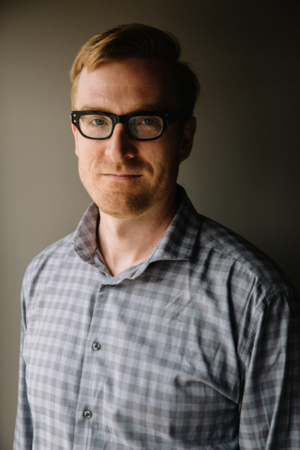
KAPLAN: Danger and Other Unknown Risks features a unique magic system. One example is the fact that a single spell with have various effects in various realms. What went into creating this system?
NORTH: The magic system in Danger and Other Unknown Risks emerged from the story, as I recall!
I’m not sure which of us suggested Marguerite have just the one spell, but we’d decided it made sense that in a fallen, magical, fracturing world, the same words might have different effects in different places. I thought they’d be roughly the same in terms of power, so a rinky-dink spell in Zone A wouldn’t be a world-ending spell in Zone B, it’d just do something different at the same rinky-dink level.
It felt both reasonable and logical (always nice with magical systems) but also a little dangerous and unpredictable (my personal preference with magical systems). And of course, every spell has its cost…
KAPLAN: What kind of challenges were associated with visually creating a world that had been fragmented into different realms by magic?
HENDERSON: In an early draft, this was a much bigger part of it than it is now. Later our emphasis became “how did different communities react to the new world.” They’re all built on top of the old but people are using the spaces and objects differently now. Ryan introduced my favorite version of this in chapter 6 (no spoilers).
NORTH: One benefit from the iterative, exploratory process we had with each other was that we COULD flesh out these things in huge detail – and then not necessarily use it in the next draft! But the benefit is we HAVE thought it all through and made all those decisions, so it made the world feel really lived-in and thought-out. It’s not necessarily all there on the page, but there’s hints towards it in the final version that give it a great depth and a satisfying internal logic.
KAPLAN: Much of your work features characters with outstanding sartorial sensibilities. How is your design process complicated by a post-apocalyptic setting (if it is)?
HENDERSON: I think a lot about fashion as an art form, but for stories I think about it as a character tool. What a person wears is important. It tells you what they’re planning on doing, how much money they have, how much money they want you to think they have, what their interests are, gender expression, the environment around them. There’s a lot of choice in how we dress. A guy that says “clothes are stupid, I don’t even care about them” still chooses what he buys. Just because a rack of tutus is the first thing he sees in a store doesn’t mean that’s what he’s getting. He still cares.
Marguerite’s clothes all come from things her uncle saved from before the world changed. She has maybe one feminine Delia’s style top, but mostly it’s stuff that she can walk around in for months on end, that a middle aged man picked out.
NORTH: I’ll just add on to this to say that when we worked on Squirrel Girl, people would sometimes compliment me on the clothing the characters wear, and how they did all the things Erica’s talking about to inform about character. And none of that’s in the script, it’s all Erica’s art!
KAPLAN: One of the main characters of this story is Daisy the dog. What went into his character design? Did you have a particular dog that served as a model? How do you manage to convey so much human emotion through animal characters?
HENDERSON: We discussed various breeds at first. Even before the writing started we had to know what Daisy would be capable of. For a while we talked about a small dog like a Boston Terrier that could get into small spaces. Eventually we settled on medium size-largeish when Ryan started writing.
I picked a Chow because they’re an ancient Chinese guard breed. They are fiercely loyal to basically one person and indifferent to others. They’re also just fun looking. I thought I shot myself in the foot by picking a dog where you can’t really see the eyes but it wound up not being that important. Animals communicate with body language. Plus there’s a lot you can do with a kind of jowly dog. A lot of mouth to work with.
NORTH: Erica and I had some talks about the size of the dog – the advantages of a big versus small dog, etc, and then some narrative conversations around it too. It really was a collaborative process at every stage, discussing possibilities, following threads through to their logical conclusion.
Even at the character design process Erica would send me different options after we spoke about what we wanted the character to feel like, which was really fun – I’m not normally involved in those conversations (though I was on our first project together with Squirrel Girl!). Big thanks to our editor on Squirrel Girl, Wil Moss, for introducing us to each other.
KAPLAN: Is there anything else you’d like me to include?
NORTH: The book is a fun, funny, and surprising adventure, and I’m really excited for it to be out in the world in readers’ hands.
Danger and Other Unknown Risks is currently available for preorder and is scheduled to arrive at your local bookstore and/or public library in April 2023.


